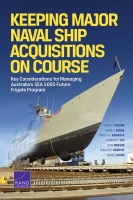Keeping Major Naval Ship Acquisitions on Course: Key Considerations for Managing Australia's SEA 5000 Future Frigate Program | RAND
Recommendations
- The Royal Australian Navy (RAN) should be an intelligent and informed partner in the acquisition process, by
- involving the appropriate organizations early and often,
- clearly assigning roles and responsibilities, and
- understanding the cost and schedule implications of options.
- RAN should clearly state its requirements.
- RAN should also understand and obtain the required intellectual property rights.
- It should strive for program stability.
- It should commence construction only after designs have been largely completed.
- RAN should maintain a strategic perspective, keeping in mind how the new platform will integrate with the capabilities of other platforms.
- Critical near-term questions facing the SEA 5000 Future Frigate program should be addressed, including
- determining the operational and performance requirements and the technical requirement for the future frigate,
- deciding on the best design option,
- deciding how to engage with industry and
- how the program office will monitor the program, and
- deciding how the class will be supported throughout its life.
RAN looks to future
 |
| ANZAC Future Frigate Concept |
Australia’s Hazard(ous) Frigate Upgrades: Done at Last
Frazer-Nash supports Australia's future frigate design
 |
| RAN’s Anzac-class workhorse due to retire in 2020 |
Top 10 International Frigates
Future Frigates today’s challenge | The Australian THE notoriously long gestation period of a major military capability means considerable effort has already been directed at the so-called Future Frigate that will replace the RAN’s eight Anzac-class workhorses sometime in the next decade.
Although the Sea 5000 program has yet to complete the requirements definition phase, there has been no shortage of debate on capability and construction issues within both Defence and industry — until recently.
One-on-one discussions in Sydney last year between Defence’s Capability Development Group and major industry players were to have been followed by a strong Defence team visiting ship designers in Europe and possibly the US.
However, that visit has been cancelled and industry informed that no further developments can be expected until after publication next year of the Defence white paper and its accompanying defence capability plan.

No comments:
Post a Comment